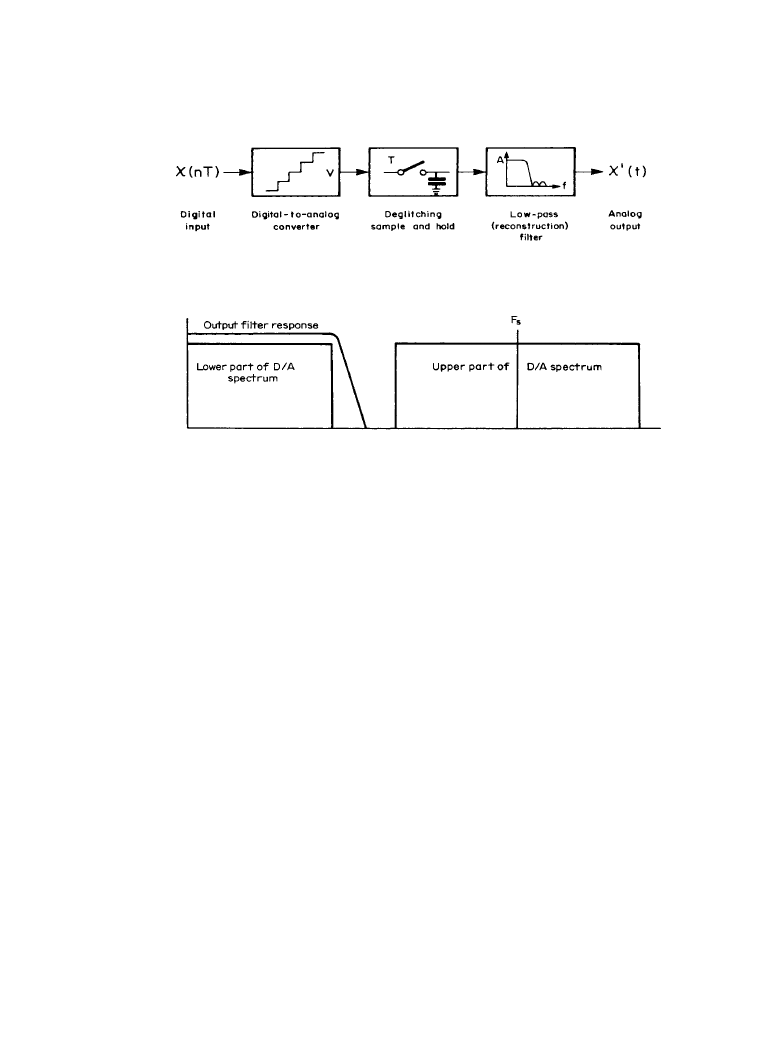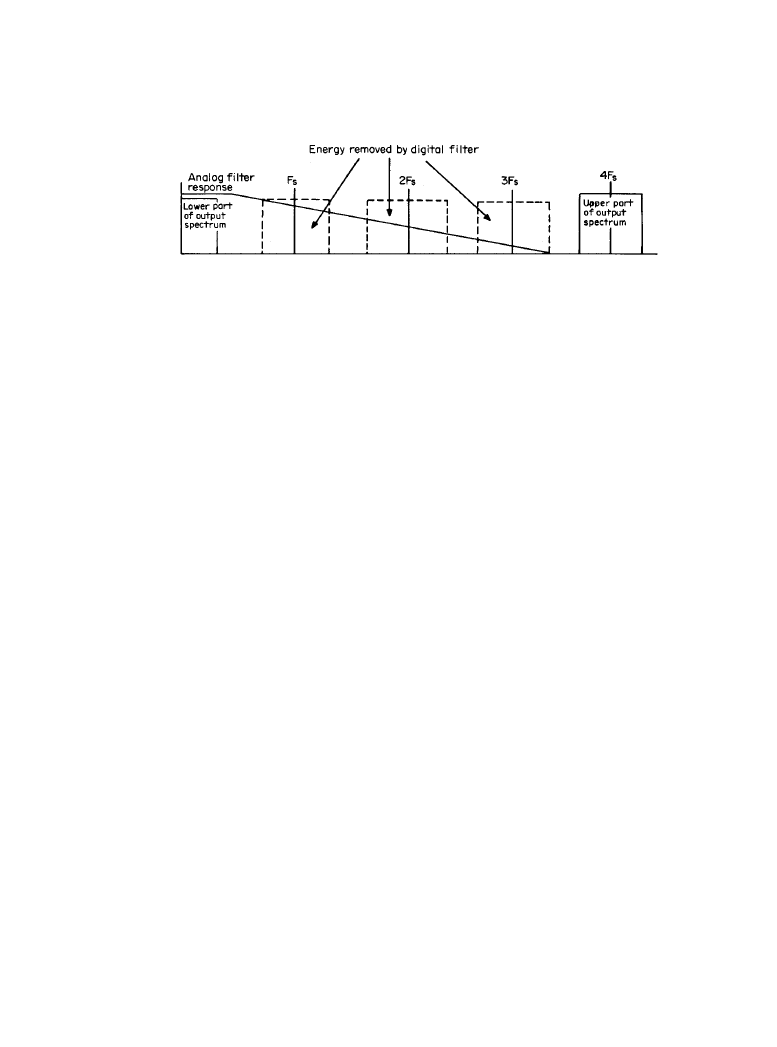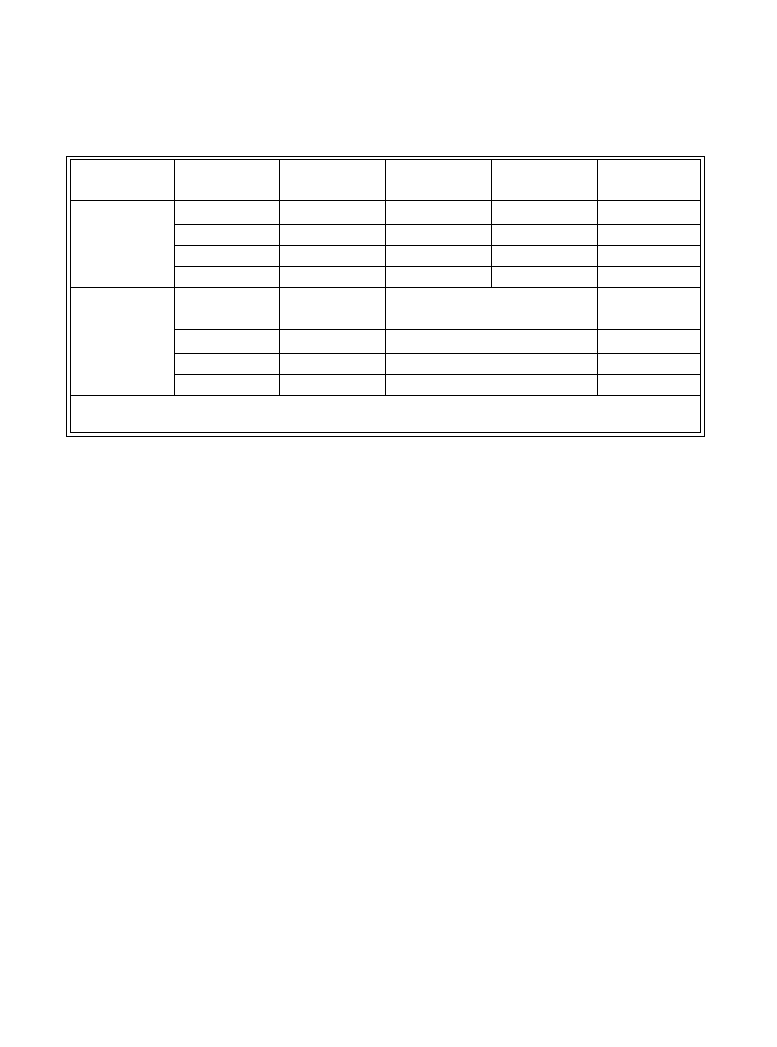ВУЗ: Казахская Национальная Академия Искусств им. Т. Жургенова
Категория: Книга
Дисциплина: Не указана
Добавлен: 03.02.2019
Просмотров: 21682
Скачиваний: 19

Analog/Digital Signal Conversion 6-11
An 8-bit flash A/D converter requires 255 comparators. The cost of high-resolution A/D com-
parators escalates as the circuit complexity increases and the number of analog converters rises
by 2
n
– 1. As a low-cost alternative, some manufacturers produce modified flash converters that
perform the A/D conversion in two steps, to reduce the amount of circuitry required. These mod-
ified flash converters also are referred to as half-flash A/D converters because they perform only
half of the conversion simultaneously.
6.1.4
The D/A Conversion Process
The digital-to-analog converter (DAC) is, in principle, quite simple. The digital stream of binary
pulses is decoded into discrete, sequentially timed signals corresponding to the original sampling
in the A/D. The output is an analog signal of varying levels. The time duration of each level is
equal to the width of the sample taken in the A/D conversion process. The analog signal is sepa-
rated from the sampling components by a low-pass filter. Figure 6.1.6 shows a simplified block
diagram of a D/A. The deglitching sample-and-hold circuits in the center block set up the analog
levels from the digital decoding and remove the unwanted high-frequency sampling components.
Each digital number is converted to a corresponding voltage and stored until the next number is
converted. Figure 6.1.7 shows the resulting spectrum. The energy surrounding the sampling fre-
quency must be removed, and an output low-pass filter is used to accomplish that task. One cost-
effective technique used in a variety of applications is called oversampling. A new sampling rate
is selected that is a whole multiple of the input sampling rate. The new rate is typically two or
four times the old rate. Every second or fourth sample is filled with the input value, while the
others are set to zero. The result is passed through a digital filter that distributes the energy in the
Figure 6.1.6
Digital-to-analog converter block diagram.
Figure 6.1.7
Output filter response requirements for a common D/A converter.
Downloaded from Digital Engineering Library @ McGraw-Hill (www.digitalengineeringlibrary.com)
Copyright © 2004 The McGraw-Hill Companies. All rights reserved.
Any use is subject to the Terms of Use as given at the website.
Analog/Digital Signal Conversion

6-12 Digital Coding of Audio Signals
real samples among the empty ones and itself. The resulting spectrum (for a 4
× oversampling
system) is shown in Figure 6.1.8. The energy around the 4
× sample frequency must be removed,
which can be done simply because it is so distant from the upper band edge. The response of the
output filter is chiefly determined by the digital processing and is therefore very stable with age,
in contrast to a strictly analog filter, whose component values are susceptible to drift with age
and other variables.
6.1.4a
Practical Implementation
To convert digital codes to analog voltages, a voltage weight typically is assigned to each bit in
the digital code, and the voltage weights of the entire code are summed [3]. A general-purpose
D/A converter consists of a network of precision resistors, input switches, and level shifters to
activate the switches to convert the input digital code to an analog current or voltage output. A D/
A device that produces an analog current output usually has a faster settling time and better lin-
earity than one that produces a voltage output.
D/A converters commonly have a fixed or variable reference level. The reference level deter-
mines the switching threshold of the precision switches that form a controlled impedance net-
work, which in turn controls the value of the output signal. Fixed-reference D/A converters
produce an output signal that is proportional to the digital input. In contrast, multiplying D/A
converters produce an output signal that is proportional to the product of a varying reference
level times a digital code.
D/A converters can produce bipolar, positive, or negative polarity signals. A four-quadrant
multiplying D/A converter allows both the reference signal and the value of the binary code to
have a positive or negative polarity.
6.1.5
Converter Performance Criteria
The major factors that determine the quality of performance of A/D and D/A converters are res-
olution, sampling rate, speed, and linearity [3]. The resolution of a D/A circuit is the smallest
possible change in the output analog signal. In an A/D system, the resolution is the smallest
change in voltage that can be detected by the system and produce a change in the digital code.
The resolution determines the total number of digital codes, or quantization levels, that will be
recognized or produced by the circuit.
Figure 6.1.8
The filtering benefits of oversampling.
Downloaded from Digital Engineering Library @ McGraw-Hill (www.digitalengineeringlibrary.com)
Copyright © 2004 The McGraw-Hill Companies. All rights reserved.
Any use is subject to the Terms of Use as given at the website.
Analog/Digital Signal Conversion

Analog/Digital Signal Conversion 6-13
The resolution of a D/A or A/D device usually is specified in terms of the bits in the digital
code, or in terms of the least significant bit (LSB) of the system. An n-bit code allows for 2
n
quantization levels, or 2
n
– 1 steps between quantization levels. As the number of bits increases,
the step size between quantization levels decreases, therefore increasing the accuracy of the sys-
tem when a conversion is made between an analog and digital signal. The system resolution also
can be specified as the voltage step size between quantization levels.
The speed of a D/A or A/D converter is determined by the amount of time it takes to perform
the conversion process. For D/A converters, the speed is specified as the settling time. For A/D
converters, the speed is specified as the conversion time. The settling time for a D/A converter
varies with supply voltage and transition in the digital code; it is specified in the data sheet with
the appropriate conditions stated.
A/D converters have a maximum sampling rate that limits the speed at which they can per-
form continuous conversions. The sampling rate is the number of times per second that the ana-
log signal can be sampled and converted into a digital code. For proper A/D conversion, the
minimum sampling rate must be at least 2 times the highest frequency of the analog signal being
sampled to satisfy the Nyquist criterion. The conversion speed and other timing factors must be
taken into consideration to determine the maximum sampling rate of an A/D converter. Nyquist
A/D converters use a sampling rate that is slightly greater than twice the highest frequency in the
analog signal. Oversampling A/D converters use sampling rates of N times rate, where N typi-
cally ranges from 2 to 64.
Both D/A and A/D converters require a voltage reference to achieve absolute conversion
accuracy. Some conversion devices have internal voltage references, whereas others accept exter-
nal voltage references. For high-performance systems, an external precision reference is required
to ensure long-term stability, load regulation, and control over temperature fluctuations.
Measurement accuracy is specified by the converter's linearity. Integral linearity is a measure
of linearity over the entire conversion range. It often is defined as the deviation from a straight
line drawn between the endpoints and through zero (or the offset value) of the conversion range.
Table 6.1.2 Representative Sampling of Converter Operating Parameters
Converter Type
Sampling Rate
Resolution
S/Nq
1
Max. Input
Frequency
Power
Consumption
A/D
400 Ms/s
2
8 bits
43 dB
1 GHz
3 W
200 Ms/s
10 bits
58 dB
400 MHz
2 W
120 Ms/s
12 bits
70 dB
350 MHz
1 W
70 Ms/s
14 bits
75 dB
300 MHz
1.3 W
D/A
Sampling Rate
Resolution
Dynamic Range
Power
Consumption
500 Ms/s
3
10 bits
80 dB
250 mW
300 Ms/s
12 bits
85 dB
300 mW
200 Ms/s
14 bits
88 dB
350 mW
Notes:
1
signal-to-quantization noise,
2
megasamples per second,
3
settling rime in megasamples per second
Downloaded from Digital Engineering Library @ McGraw-Hill (www.digitalengineeringlibrary.com)
Copyright © 2004 The McGraw-Hill Companies. All rights reserved.
Any use is subject to the Terms of Use as given at the website.
Analog/Digital Signal Conversion

6-14 Digital Coding of Audio Signals
Integral linearity also is referred to as relative accuracy. The offset value is the reference level
required to establish the zero or midpoint of the conversion range. Differential linearity, the lin-
earity between code transitions, is a measure of the monotonicity of the converter. A converter is
said to be monotonic if increasing input values result in increasing output values.
The accuracy and linearity values of a converter are specified in units of the LSB of the code.
The linearity may vary with temperature, so the values often are specified at +25°C as well as
over the entire temperature range of the device.
With each new generation of devices, A/D and D/A converter technology improves, yielding
higher sampling rates with greater resolution. Table 6.1.2 shows some typical values as this book
went to press.
6.1.6
References
1.
Benson, K. B., and D. G. Fink: “Digital Operations in Video Systems,” HDTV: Advanced
Television for the 1990s, McGraw-Hill, New York, pp. 4.1–4.8, 1990.
2.
Nyquist, H.: “Certain Factors Affecting Telegraph Speed,” Bell System Tech. J., vol. 3, pp.
324–346, March 1924.
3.
Garrod, Susan A. R.: “D/A and A/D Converters,” The Electronics Handbook, Jerry C.
Whitaker (ed.), CRC Press, Boca Raton, Fla., pp. 723–730, 1996.
4.
Garrod, Susan, and R. Borns: Digital Logic: Analysis, Application, and Design, Saunders
College Publishing, Philadelphia, pg. 919, 1991.
5.
Garrod, Susan, and R. Borns: Digital Logic: Analysis, Application, and Design, Saunders
College Publishing, Philadelphia, pg. 928, 1991.
Downloaded from Digital Engineering Library @ McGraw-Hill (www.digitalengineeringlibrary.com)
Copyright © 2004 The McGraw-Hill Companies. All rights reserved.
Any use is subject to the Terms of Use as given at the website.
Analog/Digital Signal Conversion

6-15
Chapter
6.2
Digital Filters
J. A. Chambers, S. Tantaratana, B. W. Bomar
Jerry C. Whitaker, Editor-in-Chief
6.2.1
Introduction
Digital filtering is concerned with the manipulation of discrete data sequences to remove noise,
extract information, change the sample rate, and/or modify the input information in some form
or context [1]. Although an infinite number of numerical manipulations can be applied to dis-
crete data (e.g., finding the mean value, forming a histogram), the objective of digital filtering is
to form a discrete output sequence y(n) from a discrete input sequence x(n). In some manner,
each output sample is computed from the input sequence—not just from any one sample, but
from many, possibly all, of the input samples. Those filters that compute their output from the
present input and a finite number of past inputs are termed finite impulse response (FIR) filters;
those that use all past inputs are termed infinite impulse response (IIR) filters.
6.2.2
FIR Filters
An FIR filter is a linear discrete-time system that forms its output as the weighted sum of the
most recent, and a finite number of past, inputs [1]. A time-invariant FIR filter has finite mem-
ory, and its impulse response (its response to a discrete-time input that is unity at the first sample
and otherwise zero) matches the fixed weighting coefficients of the filter. Time-variant FIR fil-
ters, on the other hand, may operate at various sampling rates and/or have weighting coefficients
that adapt in sympathy with some statistical property of the environment in which they are
applied.
Perhaps the simplest example of an FIR filter is the moving average operation described by
the following linear constant-coefficient difference equation:
Downloaded from Digital Engineering Library @ McGraw-Hill (www.digitalengineeringlibrary.com)
Copyright © 2004 The McGraw-Hill Companies. All rights reserved.
Any use is subject to the Terms of Use as given at the website.
Source: Standard Handbook of Audio and Radio Engineering